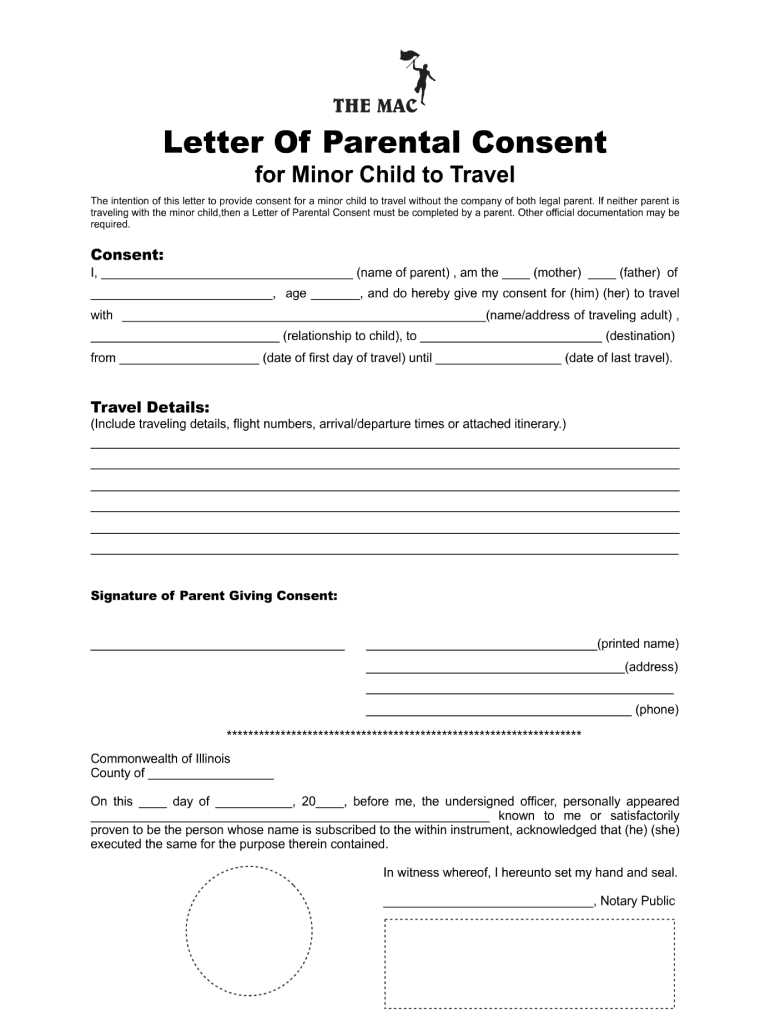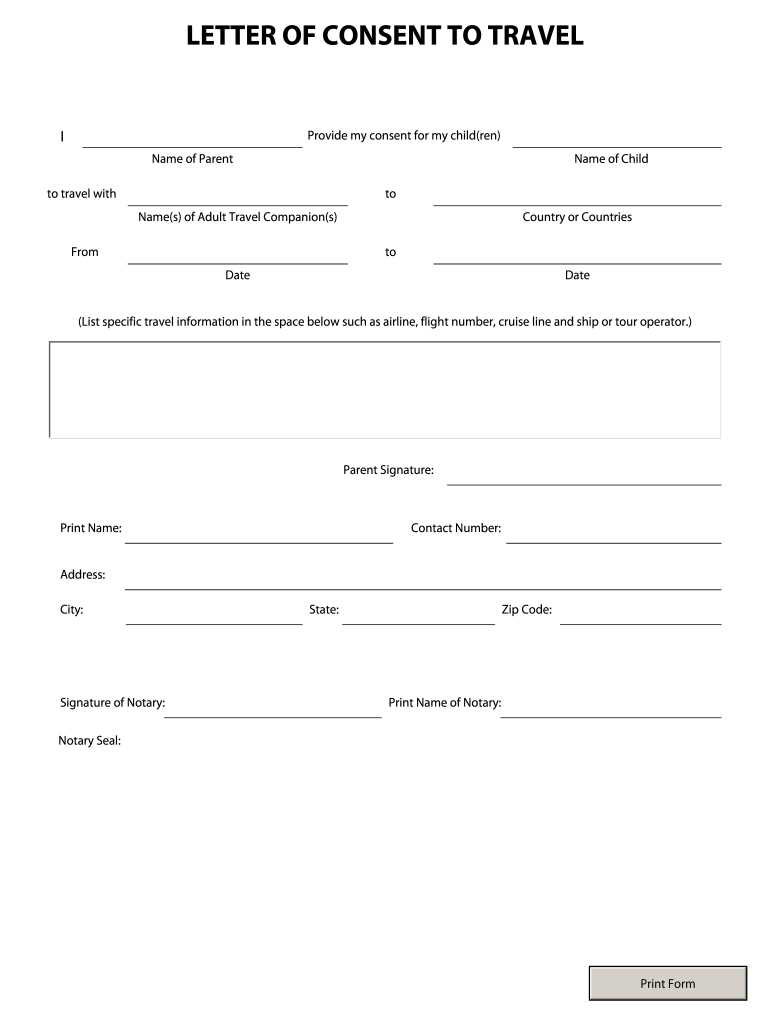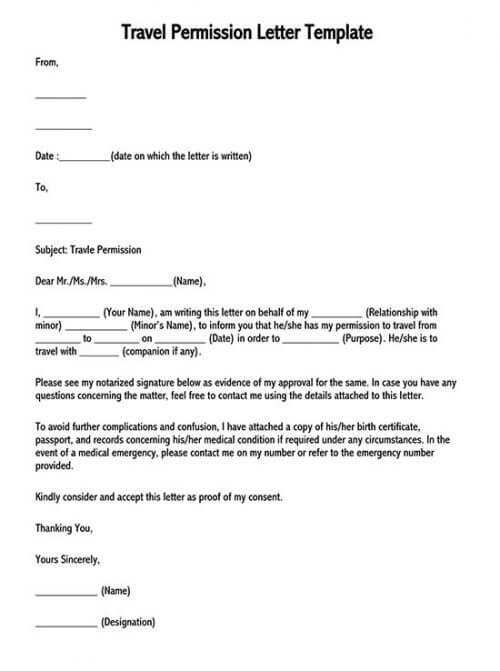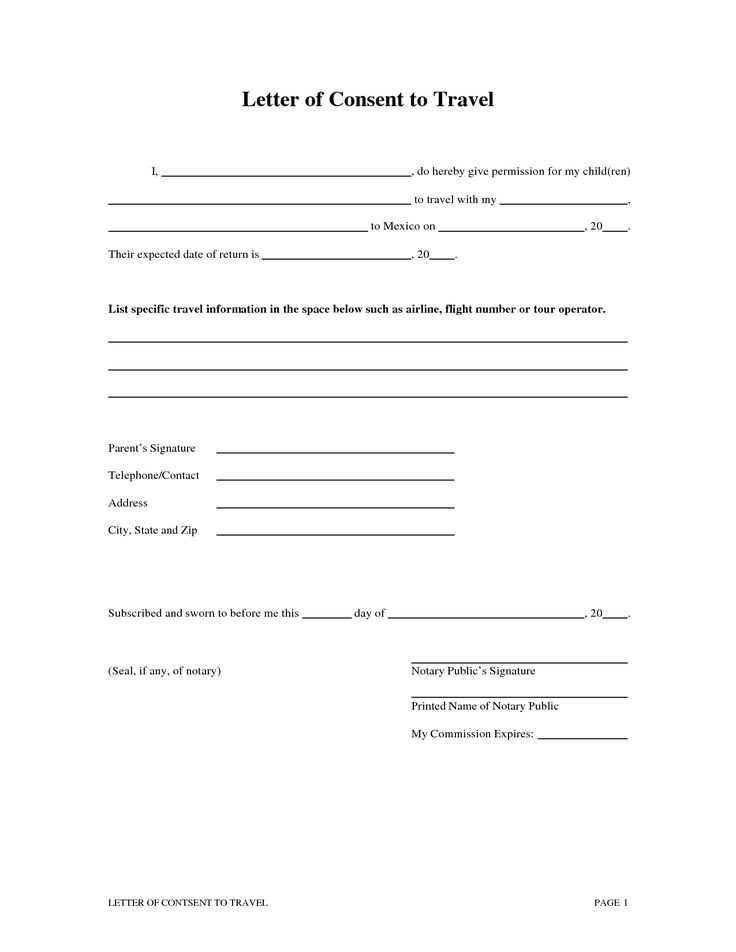Template Letter of Consent to Travel for Minors

When planning a journey for a young traveler, securing proper authorization is often a crucial step. This document ensures that the guardian or parent agrees to the minor’s trip, providing legal protection and peace of mind. It is especially important when the child will be accompanied by someone other than their legal guardian or when traveling abroad.
Creating an appropriate approval form requires attention to specific details to guarantee it meets legal requirements. The process involves outlining important information about the child’s itinerary, along with contact details and consent from the appropriate adults. By preparing this document, you avoid potential legal complications and ensure a smoother journey for both the minor and the accompanying guardian.
Having the correct authorization can prevent delays or misunderstandings with authorities, airlines, or other parties involved. It is always recommended to verify that the form includes all necessary details before submitting it to avoid any issues while on the road.
When sending a minor on a journey, it is essential to ensure proper authorization is granted. Without this document, there could be legal complications, especially when the child is traveling with someone other than their parent or guardian. The purpose of this document is to verify that the child’s legal guardians are fully aware of and approve of the trip.
Legal Importance
In many countries, the authorities require proof that a minor is traveling with the permission of their parents or legal guardians. This is especially crucial for international trips, where immigration laws may be stricter. A valid authorization can prevent delays or issues at border controls or airports, ensuring the child can continue their journey without hindrance.
Parental Responsibility
Guardians have the responsibility to ensure the safety and well-being of their child while they are away. A properly crafted permission form outlines the child’s travel details, the accompanying adult, and the guardian’s agreement to the arrangement. This form not only serves a legal purpose but also offers peace of mind to both the parents and the child during the trip.
Key Elements of an Authorization Document

An effective authorization form must include several critical details to ensure its validity. These components serve to confirm the parent or guardian’s approval, provide necessary information about the minor’s trip, and guarantee that all parties involved are fully informed. Without these key elements, the document may not be legally recognized or effective in ensuring safe and hassle-free travel.
Essential Information
Each authorization document should contain specific details to make it complete and accurate. These include the child’s personal information, the name of the accompanying adult, and an outline of the travel plans. Furthermore, the form must clarify the dates and destination, ensuring that all involved parties understand the scope of the journey.
Signatures and Dates
The signatures of the legal guardians and the person accompanying the minor are crucial. Additionally, the document should include the date it was signed to verify its timeliness. The inclusion of these signatures affirms the legal agreement and assures that the minor is permitted to take part in the journey.
| Element | Details |
|---|---|
| Minor’s Information | Full name, date of birth, passport or ID number |
| Accompanying Adult | Name, relationship to minor, contact details |
| Travel Details | Departure and return dates, destination, purpose of trip |
| Signatures | Parent/guardian and accompanying adult signatures |
| Date | Exact date when document was signed |
Creating a proper authorization document is essential to ensure the minor’s journey goes smoothly and legally. This process involves including the necessary information, ensuring accuracy, and following legal requirements. By following these steps, you can prepare a valid form that grants approval for the trip while protecting all parties involved.
1. Gather Required Information
The first step is collecting all the information you need to include in the document. This includes details about the minor, the accompanying adult, and the trip itself. The more accurate and comprehensive the information, the better the document will serve its purpose.
- Minor’s full name, date of birth, and passport/ID details
- Accompanying adult’s full name, relationship to the child, and contact information
- Specific travel dates, destinations, and any additional relevant details
2. Draft the Document
Once you have all the required information, it’s time to write the document. Start by clearly stating that you authorize the minor to travel with the accompanying adult. Include all details about the trip, and make sure to include a section for both guardians and the accompanying person to sign.
3. Review and Double-Check
Before finalizing the form, review it thoroughly to ensure all information is accurate and up to date. Missing or incorrect details could lead to delays or issues during the trip. Verify the minor’s and the accompanying adult’s details, along with travel dates and destinations.
4. Sign and Date the Document
After reviewing the document, both the legal guardians and the accompanying adult should sign and date it. This step is crucial to make the document legally valid and enforceable.
5. Make Copies

Once the document is signed, it’s a good idea to make multiple copies. Keep one for your own records, give one to the accompanying adult, and, if needed, provide one to any relevant authorities or institutions such as airlines or border control.
Legal Aspects of Journey Authorization
When sending a minor on a trip, legal regulations often require proper documentation to confirm that the guardian or parent has granted permission. This ensures that the child’s safety and well-being are prioritized, and that all legal responsibilities are met. Understanding the legal aspects of such a document is crucial to avoid complications with authorities or other institutions involved in the journey.
International Regulations
For international journeys, countries often have strict laws regarding minors traveling without their parents or legal guardians. Authorities may request proof that the child is allowed to leave the country, and in some cases, a notarized authorization may be required. This document serves as evidence that the child’s guardians have authorized the trip and agreed to the travel plans.
Domestic Guidelines
Even for domestic trips, it’s important to meet certain legal requirements to ensure smooth travel. Some regions may ask for similar documents, especially if the minor is traveling with a non-parental guardian. It’s important to check local regulations to ensure the document includes the necessary information to satisfy legal obligations and avoid delays.
Personalizing an authorization document ensures that it aligns with the specific needs of the minor’s journey. By tailoring the form to reflect accurate details about the child, the guardian, and the trip, you create a clear and legally sound record. This personalization helps avoid confusion and ensures that all involved parties have a mutual understanding of the arrangements.
Include Specific Travel Details
To make the document more relevant, include precise information about the destination, dates, and purpose of the trip. Detailing the travel route, flight numbers, and accommodation arrangements can provide added clarity. This is especially important for international trips, where customs or immigration authorities may require this information for verification.
Adjust for the Accompanying Adult
Another important aspect of personalization is adding the name and contact information of the adult accompanying the minor. Be sure to specify the relationship between the child and the adult, as this helps clarify the supervision arrangements. Including any emergency contact details for the accompanying adult can also be beneficial in case of unforeseen situations during the journey.
When Permission Forms Are Necessary

Permission forms are required in various situations to ensure that a minor is allowed to embark on a journey with the right approvals. These forms act as legal proof that a guardian or parent has given authorization for the child’s trip, safeguarding both the minor and the accompanying adult. Without proper documentation, complications can arise, especially at border control or in situations requiring proof of parental approval.
When Traveling with a Non-Guardian Adult

If a minor is traveling with an adult who is not their parent or legal guardian, a signed permission document is typically necessary. This form assures authorities that the child’s guardians are aware of and approve of the travel plans. It is especially important when the trip involves crossing international borders, as countries often have strict entry and exit requirements for minors.
International Journeys
For international trips, many countries require an authorization form to confirm that a minor has received permission from their parents or guardians. This is particularly true if the child is traveling without one or both parents. Customs and immigration authorities often ask to see this form before allowing the minor to depart or enter a country, so having it prepared in advance is essential to avoid delays or issues.